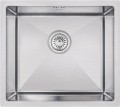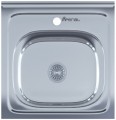Mount type
The standard way to mount the sink. Some models allow multiple ways to install, at the user’s choice. The specific options may be:
—
Mortise overhead. Models fitted in the slot of the worktop in such a way that the side of the sink is significantly above the surface of the worktop. The method of installation is quite simple, but the side raised above the table is in some cases inconvenient.
—
Mortise back to back. Models installed in the slot of the worktop so that the side of the sink is at the level of the worktop. Popular due to the ease of installation and convenience in cleaning: if necessary, water and other contaminants can be «driven» by a cloth from the table top directly to the sink. It is true that there is a small gap between the countertop and the sink where pollution can accumulate; but this disadvantage is compensated by the ease of installation.
—
Tabletop. Models fixed at the bottom of the countertop - so that the role of the sides actually play the edges of the hole cut under the sink. This method is convenient for maximum convenience in cleaning: from the kitchen table you can easily wipe into the sink spilled liquid or small debris like crumbs, while the contamination will not accumulate in the gap between the sink and the table top (As opposed to butt mounting, see corresponding paragraph. ). At the same time,
...the installation of such shells by itself is quite difficult.
— Tabletop module. Quite specific installation method: the sink is installed on the floor top, replacing the table top. For such an installation, it is necessary that the box accurately corresponds to the sink in size, so this option is quite rare.Material thickness
The thickness of the material used for washing.
More "thick" models, on the one hand, provide strength and reliability, on the other hand, they differ significantly in weight and cost of the product. And accordingly, for each material, its own standards in thickness are applied.
So for steel, the values start from
0.6 mm, and in the most "heavy" models, this indicator reaches a
thickness of 1.5 mm. The most common value (golden mean) is a
thickness of 0.8 mm, there are also
thicknesses of 1 mm and
kitchen sinks of 1.2 mmShape
The general shape of the sink. Note that this parameter is not indicated by the shape of the bowl, but by the shape of the product as a whole (although often these moments coincide).
In addition to the classical forms (
rectangular,
square,
>>> roundnon-standard design, which can have very unusual outlines. These sinks should pay attention to those who try to decorate the kitchen in an unusual style.
Overflow
Overflow has the form of an opening located at the top of the bowl; this opening must be connected to the drain by a hose. Such a device avoids the transfusion of water over the edge of the sink: when the bowl overflows, water will flow into the sewer through the overflow and will not rise above the edges.
Tap hole
Availability of space in the sink for the installation of the mixer. This hole can be cut in advance or, if necessary, knocked out during installation (the corresponding place on the model already exists and is made of a softer material).
In box
—
Tap. The presence of a tap in the kit will eliminate the search for a suitable style. On the one hand, a tap in a set simplifies the purchase of a sink, but on the other hand, it often introduces certain restrictions. Thus, taps come in different designs and capabilities, as a result of which a complete solution may not satisfy user needs. We also note that this paragraph indicates only those taps that are officially presented in the portfolio of a particular manufacturer of kitchen sinks. Such sets can be assembled within one line or without being tied to a specific series, but purely according to style.
—
Colander. The colander supplied with the sink is usually a mesh or hole bottom tray through which water can freely pass. Such a tray can be used in the same way as a common colander - for washing cereals and ready-made pasta, for washing and drying fruit, vegetables and greenery, etc.
Cutting board. Availability of cutting board in the product delivery kit. Such a board, when used, is usually attached directly to the sink; this may be especially relevant in cramped conditions where there is not much space on the kitchen table.
—
Automatic valve. Device that facilitates filling the sink with water and draining this water. It consists of the valve itself, which closes the drain opening, and an exit button or lever
..., which is installed in a convenient place - for example, near the mixer. To drain water, it is enough to press a button or lever, opening the valve - it is much more convenient and comfortable than to lower your hand in the water and reach the drain hole.
— Mesh on bowl. Mesh made of durable wire mounted over the bowl; can be made removable or foldable. This device is mainly used as a dishwasher; it can be especially useful if the kitchen does not have space for a separate dryer, or if you periodically have to deal with a large number of dishes for which a separate dryer is no longer enough.
— Detergent dispenser. Availability of a dispenser for liquid detergents. This device looks like a container with a characteristic cap and a long spout: when you press the cap, a portion of the contents is delivered through this spout. The size of each portion is very small - by pressing the required number of times, you can quite accurately dose the amount of detergent. Dispensers of this design save space in the kitchen, since most of their body is located under the sink. This affects not only the ease of use of detergents, but also the aesthetic design of the kitchen interior.
— Siphon. The presence of a siphon supply kit is a characteristic curved tube for connecting a sink drain to a sewer. The complete siphon is by definition optimally compatible with the «native» wash; it saves you the hassle of searching and selecting.Surface type
Type of washing surface made of stainless steel (cf. «Body material»).
— Glossy. Brilliant, mirror surface, distinguished by attractive appearance. On the other hand, on such a surface quickly appear contamination and mechanical damage (traces from dried water, fingerprints, scratches, etc.), so to preserve the appearance it needs to be cleaned regularly, or even polished.
— Matte. The matte surface does not look as bright as glossy - it is fainter, without pronounced reflections. On the other hand, such surfaces are less susceptible to contamination and damage: fingerprints, traces of dried water, scratches and scuffs on such surfaces are not as visible as on gloss.
— Textured. Surface having a relief pattern with a depth of a fraction of a millimeter. This material is most convenient and practical from the point of view of maintenance, it perfectly masks contamination and is well resistant to scratches. The main drawback of textured surfaces is higher cost than matt and glossy. In addition, contamination and bacteria can accumulate in grooves, so clean such sinks should be with special care.
Minimum cabinet width (base)
The smallest width of the cabinet, pedestal or other base required for the installation of the sink. By width in this case means the distance between the side walls of the cabinet (base). If the width of the sink is too small, it will not get the necessary support, and its normal use will be impossible.
Main minimum dimensions:
>less than 45 cm, 45 cm, 50 cm, 60 cm, 80 cm,
more than 80 cm.

